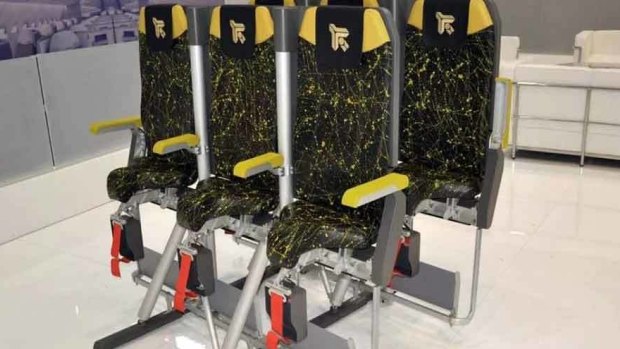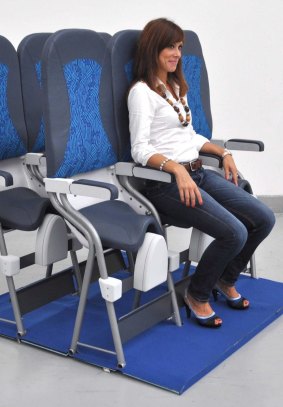This was published 4 years ago
Aviointeriors Skyrider standing seat: Why you won't see them on airlines any time soon
By Hannah Sampson

The SkyRider 3.0 design.
Like a monster in a horror film, the idea of "standing seats" on planes keeps coming back to life.
Most recently, the concept popped up last week when the Italian airline seat manufacturer Aviointeriors showed off the 3.0 version of its Skyrider model. That followed an April appearance at the Aircraft Interiors Expo in Hamburg, Germany.
It's a higher-than-normal chair that appears to have been borrowed from a bike seat to save space. Passengers would straddle the seat and lean back in something of a squat rather than a truly seated position. And despite headlines like "Here's what it might be like to travel on a stand-up airplane seat" and "New stand-up plane seats branded 'torture' and 'inhumane,' " it is not likely to appear on a plane anytime soon.

Experts have questioned the safety aspects of the design.
No airlines have placed an order for the seats, Aviointeriors engineering adviser Gaetano Perugini said on Wednesday, though he said there has been "a lot of interest." He pointed out that the tiny distance of 23 inches (58 cm) from one point on the seat to the same point on the one behind - a measurement known as seat pitch - is a complicating factor. Even the least generous low-cost carriers provide 28 inches (71 cm) of pitch.
The design is just the latest idea to capture the attention of a flying public fatigued by the impersonal, profit-driven nature of air travel today - and primed by history to expect even worse experiences ahead. Aircraft manufacturers are also thinking about ways to reinvent seating, as evidenced by patents on the books. CNN reported in 2017 that Airbus has patented its own version of a "saddle seat," as well as a configuration that would stack passengers on top of one another.
"The road to where we are today is paved with goofy patents that went nowhere," says Richard Aboulafia, an aviation analyst at Teal Group.
In a 2018 news release (when a previous version made the rounds), Aviointeriors said the design would allow airlines to increase the number of passengers by 20 per cent, boosting their profits. Perugini clarified Wednesday that airlines would still have to adhere to the total number of people allowed on a plane, but could arrange their seating to cater to travelers on different budgets. For example, if no more than 215 passengers were allowed, there could be 10 seats in business class, 137 in standard economy and 68 Skyriders, he said.
"The meaning of Skyrider is not to put thousands of people inside of a cabin, but to create a new arrangement not existing in our days in which you are able to create a multi-class configuration, but at the maximum allowed passenger capacity," Perugini says.
He described the experience as "an acceptable comfort, not the best comfort."
"Acceptable" comfort aside, experts question the safety of such a setup. Bill Waldock, a professor of safety science at Embry-Riddle Aeronautical University, said the standard way of determining seat strength would have to take into account the not-quite-seated position of the passenger.
"You look at it from a crash-readiness standpoint - there's just no way," says Waldock, director of the Crash Lab at the university's Prescott, Ariz., campus. (For his part, Perugini said the company has conducted "a lot of tests" and made refinements to the seat based on results.)
Waldock and other experts also said packing an plane with more passengers could make it difficult to meet a Federal Aviation Administration rule that requires planes to be able to fully evacuate in 90 seconds in an emergency.
Aviation authorities declined to weigh in on the seat model directly but stressed that all seats on planes must meet high standards.
"The FAA's requirements are performance based, and do not specify a type of seat design," the Federal Aviation Administration said in an email. "However, the performance standards are rigorous. In any case, the level of safety required for passengers would not change, and any seat must be shown to meet all the requirements."
Under an FAA reauthorisation bill passed last year, the agency is supposed to set a minimum standard on seat width and pitch, but those regulations are not out yet.
A spokesman for the International Civil Aviation Organization said he could not speculate on the compliance of a commercial product (such as the Skyrider), but he pointed to a provision that said all passengers should be secured by seat belts or harnesses at takeoff and landing.
As travel expert George Hobica, who founded the Airfarewatchdog.com, put it: "You'd have to be strapped in like Buzz Aldrin."
Aboulafia said his main objection to standing seats is economic. Airline prices have already come down after deregulation and the rise of low-cost - and ultra-low-cost - carriers, so what are the odds a consumer is willing to stand to pay even less?
"You look at the history of aviation, and it gets cheaper and cheaper every year, and you're kind of down to very low fares," he says. "It becomes a question of, 'Did anyone really ask for this? Is this really a case of airline and customer demand, or is this a case of supplier and engineer push?' And it sure looks like it's the second."
Still, he said the idea could be an attractive one for low-cost carriers to float with investors. Indeed, budget airlines from Ryanair to VivaColombia to Tigerair have publicly pondered the notion, though none has followed through.
Even without standing seats, flying has grown less comfortable in economy classes as airlines try to wring more revenue out of every passenger and part of a plane. Bathrooms are shrinking to fit more seats in cabins. Delta is limiting how much some seats can recline. Basic economy fares offer the lowest prices but few of the basic amenities travelers have grown used to, like choosing a seat.
Given that trend, Hobica believes airlines would love to introduce a standing-room option if they thought travellers would accept them. He said the manufacturer appears to be serious, given the investments it has made in promoting the seats. With travellers more aware of their carbon footprint, he said, they might be more willing to brave the discomfort.
"I predict that we'll see one airline, if only as a gimmick, install some of the these someday," Hobica says. "Not this year, not next year - but someday."
The Washington Post
See also: Airbus unveils new couch-style seat to replace business class
See also: Folding seats, beds in the cargo hold: The top new plane cabin designs for 2019
Sign up for the Traveller newsletter
The latest travel news, tips and inspiration delivered to your inbox. Sign up now.